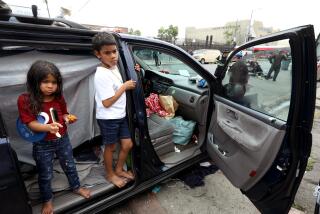Year-Round School Gets Family Nod
- Share via
Is there a crisis in San Diego’s public schools? Yes, there is, and if you look at the schools south of Interstate 8, you will see that crowded conditions are a big part of that crisis.
My children’s neighborhood school is Brooklyn Elementary. It is one of many that is experiencing explosive enrollment growth that will continue until the end of the century. Brooklyn was a great school when our two older daughters attended it several years ago, and there still is a solid group of dedicated staff and teachers.
But our two younger daughters experienced the decline that comes when 200 additional children are enrolled on an already crowded campus. The cafeteria became so crowded that there was not enough time for all the children to be served, eat and return to class before the next shift came in. Discipline problems increased in the halls and crowded playground.
To make matters worse, the crowding had only just begun. New apartments were being built that would bring even more children to the school. Our school faced some tough decisions.
Should we bus our kids to less crowded schools many miles away? No one wanted forced busing out of the neighborhood.
Should we close the much-needed, state-funded preschool and use library and reading lab space for classrooms? We could handicap the children by doing this, and there still wouldn’t be enough classroom space.
Some schools hold classes in the hallways. We could do that.
Double sessions were possible, but the children need more class time, not less.
The school could have expanded by condemning neighboring property on which to build classrooms. I couldn’t support spending taxpayers money to build new classrooms when the school was vacant one quarter of the year. Besides, money was desperately needed for school programs that were already being cut back.
And yet something had to be done immediately to relieve the crowded conditions. There was one viable option left open, and the parents’ committee and school staff supported it--implementing a year-round, four-track scheduling system.
Year-round school was easy for my family to recommend because our children have successively attended a year-round program for 11 years, and we love it.
Vacations are more frequent and usually no longer than one month. Shorter vacation time makes it easier for us parents to cope, and the kids don’t get bored as easily. Family vacations can often be planned to avoid peak tourist seasons.
While vacations are important, they are not as important as education. Learning retention appears to be greater when vacations are shorter and the children have more of them to look forward to.
On the other hand, four-track scheduling was new to us. In the four-track system, students are divided into four groups. Each group begins the year at different times and has different vacations, except for winter and spring breaks. All the children from a family are kept on the same track. The school encourages the family to choose the track it prefers.
We had to decide which track would best serve our family needs. We tried to coordinate with junior and senior high school schedules and with our children’s desire to attend class with their friends. It is not always possible to accomplish all this, and we didn’t. The school did give us the track we wanted. In fact, fewer than half the families expressed a preference.
The four-track, year-round system is not the easiest way for a school to meet the educational needs of its children. Teachers, administrators and parents have some awkward adjustments to make. For example: teachers can’t always keep the same classrooms, maintenance is difficult when the rooms are usually occupied, and record keeping is tricky.
In spite of the difficulties, the four-track, year-round system is better than cramming kids into an overcrowded campus or wasting taxpayers money on under-utilized classroom space.
A visit to Brooklyn Elementary School proved to me that we made the best decision. Classrooms are now used the entire year, and the crowding decreased by almost 25%. There are fewer students in some classrooms, more room on the playground, and the children can be fed in the cafeteria and returned to class on time.
I have seen statistics showing that crowded school conditions diminish classroom performance, and I believe them. Four-track, year-round scheduling should be implemented long before schools are packed to the crisis point. It has been suggested that when elementary school enrollment surpasses 700, the schedule should automatically shift to year-round, four-track.
There is some opposition to year-round programs. Some people believe that students living south of Interstate 8 are educationally deprived, as evidenced by their generally lower test scores. They object to “penalizing” these students even more by imposing a strange new schedule.
But my children all say they prefer year-round school and have thrived on it for their entire school careers. In fact, my family believes it is better than the traditional school year and opens the door to the possibility of a superior education for all children.
More to Read
Sign up for Essential California
The most important California stories and recommendations in your inbox every morning.
You may occasionally receive promotional content from the Los Angeles Times.













